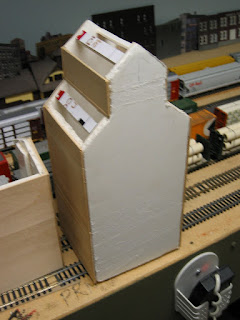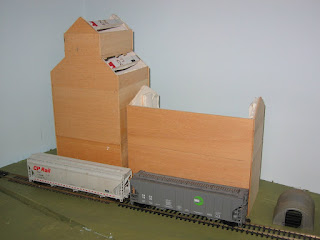A couple of Canadian blogs I like to follow are Confessions of a Train Geek and Trackside Treasure.
Confessions of a Train Geek, by Steve Boyko, contains photos and posts about railways and railfanning in Canada (and, occasionally, in the U.S.) He also has pages about BNSF in Manitoba, the Central Manitoba Railway, CN in New Brunswick, Industrial Railways, the New Brunswick Southern Railway, the New Brunswick East Coast Railway, the Prairie Dog Central and VIA Rail.
You can find it at http://blog.traingeek.ca/
Another one is Trackside Treasure, by Eric. "Trips, trains and thirty years trackside with Canada's railways," he says at the top of the page. "100% Canadian Prototype Railroading. If you're looking for variety in Canadian freight and passenger railroading, with a retrospective flavour, you won't be disappointed."
You can find it at http://tracksidetreasure.blogspot.com/
Saturday, September 18, 2010
Saturday, September 11, 2010
Prairie Giants

The UGG elevator at Turney, Manitoba.
Prairie giants . . . that's what the traditional wood crib elevators were called. Like giants, they were visible from a long ways away. To travellers, they were signs of civilization—wherever you saw a grain elevator, you knew there was a town. Even early aviators used them to help them navigate across the prairie provinces!
(Towns also ranked themselves by the number of elevators; if you came from a three-elevator town, you came from a big and important place.)
Since I am modelling the transition from the Canadian shield to the prairies, I needed grain elevators on the CP Rail Manitoba & Minnesota Subdivision. When I started building the layout, the only commercial kits available were much too small, so I decided to build my own.
As has been said on this blog many times before, I'm no expert craftsman or perfect modeller; my models will never win any contests. As with everything else I do on the layout, I strive for "good enough." Does it look like a prairie elevator? If yes, then it's good enough for me.
The method I like best for making elevators is to build a subframe out of foamcore, then glue on wood siding. (You could use styrene, too.) The trick is to make them big enough to be plausible—in real life, they are really tall—but not so tall as to dominate the scene.
The shingles are made from file cards, cut in strips and then cut to represent shingles.
The photos below show some of the construction process.

The elevator from the back, showing the
foamcore and the roof bracing. No back is
needed since it abuts the backdrop.

The annex from the front.

The annex from the back. No back is needed since
it abuts the backdrop.

The elevator from the front.

Before the roofs and scenery are added.

Another view of the elevator, with The Canadian
passing in the foreground.

Another elevator built using a similar
method, this one at Nance, MN.
Wednesday, September 8, 2010
The Fort Frances Yard

East end of the Fort Frances yard, with the Peace River
paper mill in the background.
People sometimes ask where I came up with my layout design. Did I use a book? It came out of my head, is the answer. But not fully-formed: The original design went through several changes—the helix moved from one place to another, and I “daylighted” a tunnel. But nothing went through more changes than the yard.

Looking west from the engine facility,
I must have laid and relaid the yard tracks a dozen times before I came up with a design that worked. I started with the mainline in the front and the yard tracks in the back, then moved the mainline to the back and the yard in front. The yard tracks began stub-ended, but ended up with switches at either end.

The Fort Frances yard, looking east.
The engine facility was on the left side, then moved to the right. Industrial spurs came and went, and I even added a fourth passing track before all was said and done.
It was almost the last section of the layout to be ballasted; I didn’t want to glue anything down until I was totally satisfied with the design.

Looking west, with the yard lead wrapping around on
the left, the intermodal facility on the right.
The way the yard works is this: Fort Frances is a junction between two mainlines—one headed east to Thunder Bay, the other south to Duluth/Superior. Trains arriving at Fort Frances drop off and pick up cars destined for other places. The yard switcher picks off the cars that are to be dropped off from the end of the train, and adds the cars that are headed out. Crews also change here, although power isn’t changed.
At the end of it all, I have a yard that works pretty well. It took a while to arrive at a design that fit the bill, but the wait was worth it.
Go to http://www.youtube.com/watch?v=TQ5MwgcUMJQ to see a video of switching action in the Fort Frances yard.

The yard trackplan, from Railroad Model Craftsman.
It's pretty close to reality.
Sunday, September 5, 2010
Dugald: A Fine Prairie Town

What could be more quintessentially prairie than a train and a grain elevator? CN 2502 and 2507, both Dash 9-44CWL units, lead a train out of the siding at Dugald, Manitoba, about 20 kilometres east of Winnipeg, on a fine morning in July, 2010.
Dugald is the site of one of Canada's worst train disasters. On this spot on Sept. 1, 1947, the westbound Minaki Campers’ Special hit a standing passenger train head on, claiming 31 lives. You can read more about the Dugald train disaster at http://www.mhs.mb.ca/docs/features/dugaldtraindisaster/index.shtml

2502 and 2507 depart Dugald for Winnipeg.
Thursday, September 2, 2010
Glint Photos
Subscribe to:
Posts (Atom)




